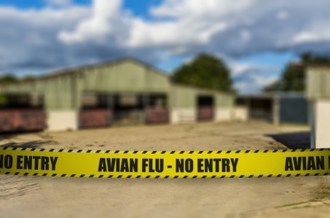What is Avian Influenza?

Avian influenza (commonly known as Bird Flu) is primarily a disease of birds and is caused by Avian Influenza Type A viruses. There are many different strains which are classified according to the severity of the disease in poultry – either low pathogenicity (LPAI – most strains) or high pathogenicity (HPAI such as H5 or H7 types). Infected animals spread the virus via their body secretions – blood, saliva, tears and faeces.
Although rare, avian influenza viruses can occasionally infect humans – usually after close, prolonged and unprotected contact with infected poultry. Human illness typically results in mild to moderate symptoms of conjunctivitis or influenza-like illness but infection with some viruses such as A(H5N1), A(H5N6), and A(H7N9), can range from mild symptoms to severe and fatal disease.
Who is at Risk?
Workers who may be at risk of infection are those who encounter infected birds or poultry (whether live or dead), virus-contaminated materials or environments. Workers may be exposed via breathing in aerosols or dust containing the virus or via direct contact with contaminated animals, surfaces or materials such as contaminated PPE. Examples of workers who may be at risk include:
- Poultry farmers, poultry processing workers and poultry processing equipment service technicians.
- People who handle infected birds or poultry or their carcasses, for example, veterinarians, Department of Agriculture workers, National Parks and Wildlife workers, local authority workers and workers involved in disease control and eradication.
- People caring for birds such as animal health workers, zoo keepers, bird keepers, bird sanctuary workers, veterinary staff and pet shop workers.
- Workers travelling to countries with avian influenza outbreaks.
- Healthcare and laboratory workers.
Food handlers most at risk of exposure to avian influenza include workers who butcher, handle, work with or package raw poultry in retail establishments and restaurants such as chefs or cooks. However, good agricultural biosecurity procedures should prevent contaminated poultry reaching these workers.
Preventing Infection
- Follow good agriculture biosecurity practices and procedures.
- Avoid direct contact with dead or potentially infected wild birds and poultry. When travelling abroad for work avoid places with live birds for example, poultry farms or bird markets. Use mechanical means for handling dead birds or poultry.
- Use good work practices. For example, provide adequate ventilation and use dust suppression techniques. Clean and disinfect areas. Note: contact with organic material such as dust, dirt, litter, and manure can decrease the effectiveness of some disinfectants.
- Follow good hygiene practices. For example, cover cuts and abrasions with waterproof plasters, wash hands after handling livestock and especially after handling infected birds or contaminated equipment and clothing. Avoid touching the mouth, eyes, or nose.
- Provide appropriate Personal Protective Equipment (PPE) based on risk assessment. For example:
- Protective clothing such as gloves, longed sleeved coveralls and a waterproof apron, to protect direct skin contact. Heavy duty protective gloves will be required where birds may pierce skin. Disposable shoe or boot covers may also help prevent spread.
- Eye protection – to prevent direct exposure to aerosols, contaminated dust or to stop the worker touching their eyes with contaminated hands. Safety goggles or face shields will protect against splashes or spray to the face.
- Respiratory protective equipment – note: filtering face pieces such as a FFP3 respirator will protect against dust (subject to face fit testing and correct use) but not against other hazards such as ammonia.
- Train and instruct workers: for example on how to minimise dust generation, correct use of disinfectants, correct method of putting on (donning), taking off (doffing) and disposal of PPE, the signs and symptoms of infection in humans and the action in event of such.
- Offer vaccination for the most recent seasonal human influenza vaccine to reduce likelihood of co-infection.
- If exposed to infected birds or poultry, monitor workers for any signs and symptoms of disease.
- Healthcare and laboratory workers must take account of the requirements of the Biological Agents Code of Practice.
Further Information
- Avian Influenza (Bird Flu) (DAFM).
- Avian Influenza and factsheets (HPSC).
- Avian Influenza (FSAI).
- Facts about Avian Influenza in humans (ECDC).
- Bird Flu (Avian Influenza) (HSE-NI).
- Influenza (Avian and Other Zoonotic) (WHO)
